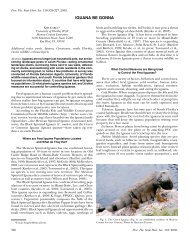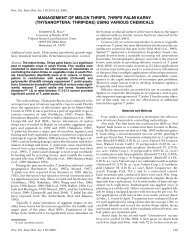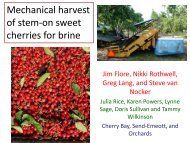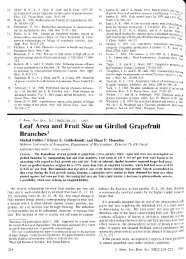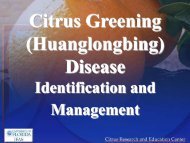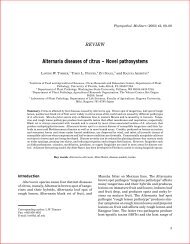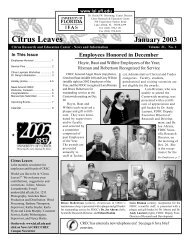Effects of mineral nutrition on health and performance of citrus trees
Effects of mineral nutrition on health and performance of citrus trees
Effects of mineral nutrition on health and performance of citrus trees
You also want an ePaper? Increase the reach of your titles
YUMPU automatically turns print PDFs into web optimized ePapers that Google loves.
<str<strong>on</strong>g>Effects</str<strong>on</strong>g> <str<strong>on</strong>g>of</str<strong>on</strong>g> <str<strong>on</strong>g>mineral</str<strong>on</strong>g> <str<strong>on</strong>g>nutriti<strong>on</strong></str<strong>on</strong>g> <strong>on</strong> <strong>health</strong><br />
<strong>and</strong> <strong>performance</strong> <str<strong>on</strong>g>of</str<strong>on</strong>g> <strong>citrus</strong> <strong>trees</strong><br />
By Arnold Schumann, Tim Spann,<br />
Tim Mann, Tom Obreza <strong>and</strong> M<strong>on</strong>gi Zekri<br />
Mineral nutrients are essential for plant growth <strong>and</strong><br />
development, <strong>and</strong> are important factors in plantdisease<br />
interacti<strong>on</strong>s. In general, <strong>health</strong>y, wellnourished<br />
plants resist or tolerate diseases better than weak,<br />
malnourished plants. How each nutrient affects a plant’s<br />
resp<strong>on</strong>se to disease is unique to each plant-disease complex.<br />
The purpose <str<strong>on</strong>g>of</str<strong>on</strong>g> this article is to briefly summarize some <str<strong>on</strong>g>of</str<strong>on</strong>g><br />
what we know about plant <str<strong>on</strong>g>mineral</str<strong>on</strong>g> <str<strong>on</strong>g>nutriti<strong>on</strong></str<strong>on</strong>g> <strong>and</strong> how different<br />
nutrients affect <strong>citrus</strong> diseases, pests <strong>and</strong> overall tree<br />
<strong>performance</strong>.<br />
Although nutrient-pathogen interacti<strong>on</strong>s are not well<br />
understood, plant nutrients may affect disease susceptibility<br />
by changing internal functi<strong>on</strong>s that create a more favorable<br />
envir<strong>on</strong>ment for disease. Pathogen infecti<strong>on</strong> alters the plant’s<br />
physiology, particularly the uptake, transport <strong>and</strong> use <str<strong>on</strong>g>of</str<strong>on</strong>g> <str<strong>on</strong>g>mineral</str<strong>on</strong>g><br />
nutrients. Pathogens may immobilize nutrients in the soil<br />
or in infected tissues. They may also interfere with nutrient<br />
Table 1. Essential <str<strong>on</strong>g>mineral</str<strong>on</strong>g> nutrients required by plants, their general<br />
abundance relative to nitrogen, <strong>and</strong> their key functi<strong>on</strong>(s)<br />
Nutrient Chemical Relative Functi<strong>on</strong><br />
symbol abundance (%) in plant<br />
Nitrogen N 100 Proteins, amino acids<br />
Phosphorus P 6 Nucleic acids, ATP<br />
Potassium K 25 Catalyst, i<strong>on</strong> transport<br />
Calcium Ca 12.5 Cell wall comp<strong>on</strong>ent<br />
Magnesium Mg 8 Part <str<strong>on</strong>g>of</str<strong>on</strong>g> chlorophyll<br />
Sulfur S 3 Amino acids<br />
Ir<strong>on</strong> Fe 0.2 Chlorophyll synthesis<br />
Copper Cu 0.01 Comp<strong>on</strong>ent <str<strong>on</strong>g>of</str<strong>on</strong>g> enzymes<br />
Manganese Mn 0.1 Activates enzymes<br />
Zinc Zn 0.03 Activates enzymes<br />
Bor<strong>on</strong> B 0.2 Cell wall comp<strong>on</strong>ent<br />
Molybdenum Mo 0.0001 Involved in N fixati<strong>on</strong><br />
Chlorine Cl 0.3 Photosynthesis reacti<strong>on</strong>s<br />
Figure 1. A<br />
schematic repre-<br />
sentati<strong>on</strong> <str<strong>on</strong>g>of</str<strong>on</strong>g> the<br />
Mineral nutrients table.indd 1 6/17/10 9:02:18 AM<br />
relative balance<br />
<str<strong>on</strong>g>of</str<strong>on</strong>g> nutrients for<br />
<strong>citrus</strong>. All <str<strong>on</strong>g>of</str<strong>on</strong>g> the<br />
nutrients are<br />
required <strong>and</strong> must<br />
be present in the<br />
proper ratios to<br />
build a balanced<br />
<strong>and</strong> complete<br />
pyramid.<br />
Drawing from<br />
Arnold W.<br />
Schumann,<br />
©2009<br />
CITRUS INDUSTRY • July 2010<br />
<strong>and</strong> water movement or water use in the plant, inducing additi<strong>on</strong>al<br />
stresses. Such infecti<strong>on</strong>s can cause root starvati<strong>on</strong>,<br />
wilting <strong>and</strong> plant decline or death, even though the pathogen<br />
itself may not be directly harmful.<br />
Still other pathogens may themselves utilize nutrients,<br />
which reduces nutrient availability <strong>and</strong> increases the plant’s<br />
susceptibility to infecti<strong>on</strong>. Soil-borne pathogens comm<strong>on</strong>ly<br />
infect plant roots, reducing the plant’s ability to take up water<br />
<strong>and</strong> nutrients. The resulting nutrient deficiencies may, in turn,<br />
lead to sec<strong>on</strong>dary infecti<strong>on</strong>s by other pathogens.<br />
There are at least 13 <str<strong>on</strong>g>mineral</str<strong>on</strong>g> nutrients that are essential<br />
for normal plant growth <strong>and</strong> development. These nutrients<br />
<strong>and</strong> their general relative abundance <strong>and</strong> roles in <strong>citrus</strong> <strong>trees</strong><br />
are illustrated in Table 1 <strong>and</strong> Figure 1. Mineral nutrients are<br />
<str<strong>on</strong>g>of</str<strong>on</strong>g>ten viewed simply as plant food necessary for better plant<br />
growth <strong>and</strong> yield. Although disease resistance is also c<strong>on</strong>trolled<br />
by genetics, <str<strong>on</strong>g>mineral</str<strong>on</strong>g> <str<strong>on</strong>g>nutriti<strong>on</strong></str<strong>on</strong>g> can have an influence<br />
<strong>on</strong> plant resistance or susceptibility to pathogens <strong>and</strong> pests.<br />
In additi<strong>on</strong>, some disease-resistant genes in plants will <strong>on</strong>ly<br />
activate via specific envir<strong>on</strong>mental stimuli. Mineral nutri-<br />
ti<strong>on</strong> is an envir<strong>on</strong>mental factor that can be<br />
easily c<strong>on</strong>trolled in agricultural systems<br />
through fertilizer management.<br />
RESISTANCE MECHANISMS<br />
In order to complement disease <strong>and</strong><br />
pest c<strong>on</strong>trol methods, we must underst<strong>and</strong><br />
how <str<strong>on</strong>g>mineral</str<strong>on</strong>g> nutrients affect disease<br />
resistance in plants. Altering how plants<br />
resp<strong>on</strong>d to attacks by pests or diseases can<br />
increase resistance. There are three primary<br />
resistance mechanisms that <str<strong>on</strong>g>mineral</str<strong>on</strong>g><br />
<str<strong>on</strong>g>nutriti<strong>on</strong></str<strong>on</strong>g> can affect:<br />
1. Formati<strong>on</strong> <str<strong>on</strong>g>of</str<strong>on</strong>g> mechanical barriers to<br />
resist attack primarily through the development<br />
<str<strong>on</strong>g>of</str<strong>on</strong>g> thicker cell walls.<br />
2. Synthesis <str<strong>on</strong>g>of</str<strong>on</strong>g> natural defense compounds<br />
such as phytoalexins, antioxidants<br />
<strong>and</strong> flavenoids that provide protecti<strong>on</strong><br />
against pathogens.<br />
3. Activati<strong>on</strong> <str<strong>on</strong>g>of</str<strong>on</strong>g> systemic plant<br />
defense mechanisms.<br />
Plants with optimal <str<strong>on</strong>g>nutriti<strong>on</strong></str<strong>on</strong>g>al<br />
status have the highest resistance<br />
(tolerance) to pests <strong>and</strong> diseases.<br />
Susceptibility increases as nutrient<br />
c<strong>on</strong>centrati<strong>on</strong>s deviate from<br />
this optimum. Since the roles <str<strong>on</strong>g>of</str<strong>on</strong>g><br />
<str<strong>on</strong>g>mineral</str<strong>on</strong>g> nutrients are well established<br />
in host-disease interacti<strong>on</strong> <str<strong>on</strong>g>of</str<strong>on</strong>g><br />
many crops, <strong>citrus</strong> growers should<br />
recognize the existence <str<strong>on</strong>g>of</str<strong>on</strong>g> such<br />
interacti<strong>on</strong>s <strong>and</strong> see the possibilities<br />
<strong>and</strong> limitati<strong>on</strong>s for disease <strong>and</strong><br />
pest c<strong>on</strong>trol by <str<strong>on</strong>g>mineral</str<strong>on</strong>g> <str<strong>on</strong>g>nutriti<strong>on</strong></str<strong>on</strong>g><br />
<strong>and</strong> fertilizer applicati<strong>on</strong>s.<br />
Potassium (K) <strong>and</strong> calcium (Ca)<br />
play key roles in forming an effective<br />
barrier to infecti<strong>on</strong>s. Cellulose<br />
in plant cell walls requires K for
Figure 2. Corky vein<br />
symptoms associated with<br />
bor<strong>on</strong> deficiency in <strong>citrus</strong><br />
synthesis. Thus, K deficiency can cause cell walls to leak<br />
cell c<strong>on</strong>tents, creating an envir<strong>on</strong>ment that stimulates fungal<br />
growth. When K, Ca <strong>and</strong> <str<strong>on</strong>g>of</str<strong>on</strong>g>ten nitrogen (N) are deficient,<br />
plants are more susceptible to bacterial attack. L<strong>on</strong>g-term<br />
research with K has shown that sufficient K reduced bacterial<br />
<strong>and</strong> fungal diseases 70 percent <str<strong>on</strong>g>of</str<strong>on</strong>g> the time <strong>and</strong> injury<br />
from insects <strong>and</strong> mites 60 percent <str<strong>on</strong>g>of</str<strong>on</strong>g> the time. Unlike other<br />
nutrients, the generalizati<strong>on</strong> can be made for K that a sufficient<br />
supply usually increases resistance to attack by all<br />
pests. K deficiency created by over-applicati<strong>on</strong> <str<strong>on</strong>g>of</str<strong>on</strong>g> dolomite or<br />
magnesium lowers this resistance. Ca <strong>and</strong> bor<strong>on</strong> (B) deficiencies<br />
also cause <str<strong>on</strong>g>mineral</str<strong>on</strong>g> imbalances that lower resistance<br />
to diseases by creating a more favorable envir<strong>on</strong>ment for<br />
pathogen growth.<br />
A frequent symptom <str<strong>on</strong>g>of</str<strong>on</strong>g> B deficiency in <strong>citrus</strong> is the<br />
development <str<strong>on</strong>g>of</str<strong>on</strong>g> “corky” tissue al<strong>on</strong>g leaf veins <strong>and</strong> stems as<br />
a result <str<strong>on</strong>g>of</str<strong>on</strong>g> the irregular (misshapen) cell growth that occurs<br />
when B is deficient (Figure 2). These irregular cells are like<br />
microscopic wounds through which bacteria can enter. Bor<strong>on</strong><br />
deficiency reduces fruit size <strong>and</strong> juice quality <strong>and</strong> causes<br />
premature fruit drop <strong>and</strong> death <str<strong>on</strong>g>of</str<strong>on</strong>g> terminal growing points<br />
<strong>on</strong> the main stem <str<strong>on</strong>g>of</str<strong>on</strong>g> <strong>citrus</strong> <strong>trees</strong>. Parasites that live <strong>on</strong> dying<br />
tissue or that release toxins to damage or kill host plants<br />
thrive in low N situati<strong>on</strong>s. While sufficient N increases plant<br />
resistance to most bacterial diseases, excessive N can have<br />
the opposite effect because rapidly growing high N tissues<br />
can have low resistance to attack. In additi<strong>on</strong>, bacteria that<br />
depend <strong>on</strong> living tissue for a food source actually increase<br />
with high N.<br />
Mineral <str<strong>on</strong>g>nutriti<strong>on</strong></str<strong>on</strong>g> also affects the formati<strong>on</strong> <str<strong>on</strong>g>of</str<strong>on</strong>g> mechanical<br />
barriers in plant tissue. As leaves age, the accumulati<strong>on</strong> <str<strong>on</strong>g>of</str<strong>on</strong>g><br />
silic<strong>on</strong> (Si – a n<strong>on</strong>-essential beneficial element) in cell walls<br />
helps form a protective barrier to fungal penetrati<strong>on</strong>. Exces-<br />
sively high N c<strong>on</strong>centrati<strong>on</strong> lowers Si c<strong>on</strong>tent by growth<br />
diluti<strong>on</strong> <strong>and</strong> increases susceptibility to diseases. Copper<br />
(Cu) is a plant nutrient that is widely used as a fungicide.<br />
Its acti<strong>on</strong> relies <strong>on</strong> direct applicati<strong>on</strong> to the plant surface<br />
<strong>and</strong> the infecting fungi. From a <str<strong>on</strong>g>nutriti<strong>on</strong></str<strong>on</strong>g>al perspective,<br />
Cu deficiency leads to impaired producti<strong>on</strong> <str<strong>on</strong>g>of</str<strong>on</strong>g> defensive<br />
compounds, accumulati<strong>on</strong> <str<strong>on</strong>g>of</str<strong>on</strong>g> soluble carbohydrates, <strong>and</strong><br />
reduced wood development — all <str<strong>on</strong>g>of</str<strong>on</strong>g> which c<strong>on</strong>tribute<br />
to reducti<strong>on</strong> in disease resistance. As Cu deficiency develops,<br />
twigs start to decline. Weak twigs will bear very<br />
small leaves <str<strong>on</strong>g>of</str<strong>on</strong>g> yellow-green color. Fruit splitting <strong>and</strong><br />
fruit drop are comm<strong>on</strong> <strong>on</strong> <strong>citrus</strong> <strong>trees</strong> showing symptoms<br />
<str<strong>on</strong>g>of</str<strong>on</strong>g> Cu deficiency.<br />
Soil-applied manganese (Mn) can inhibit the growth<br />
<str<strong>on</strong>g>of</str<strong>on</strong>g> certain fungi. Visual factors such as leaf color are<br />
important factors in insect <strong>and</strong> mite pest attracti<strong>on</strong> <strong>and</strong><br />
susceptibility. Nutriti<strong>on</strong>al deficiencies discolor leaf surfaces<br />
<strong>and</strong> may increase susceptibility to pests that are attracted<br />
to yellow. The Asian <strong>citrus</strong> psyllid, Diaphorina citri, for<br />
example, tends to settle <strong>on</strong> young leaf surfaces that are yellow<br />
in color.<br />
Three primary pest defenses <str<strong>on</strong>g>of</str<strong>on</strong>g> plants are:<br />
1. Physical surface properties: color, hairs.<br />
2. Mechanical barriers: tough fibers, silic<strong>on</strong> crystals,<br />
wood formati<strong>on</strong>.<br />
3. Chemical/biochemical: c<strong>on</strong>tent <str<strong>on</strong>g>of</str<strong>on</strong>g> attractants, toxins,<br />
repellants.<br />
Mineral <str<strong>on</strong>g>nutriti<strong>on</strong></str<strong>on</strong>g> affects all three defense systems. There<br />
is <str<strong>on</strong>g>of</str<strong>on</strong>g>ten a correlati<strong>on</strong> between N applicati<strong>on</strong>s (stimulati<strong>on</strong><br />
<str<strong>on</strong>g>of</str<strong>on</strong>g> growth) <strong>and</strong> pest attack. B deficiency reduces the resistance<br />
to pest attack in the same way it reduces resistance<br />
to fungal infecti<strong>on</strong>s. B is used in the synthesis <str<strong>on</strong>g>of</str<strong>on</strong>g> flavenoids<br />
<strong>and</strong> phenolic compounds, which are a part <str<strong>on</strong>g>of</str<strong>on</strong>g> the plant’s<br />
biochemical defense system.<br />
A sufficient supply <str<strong>on</strong>g>of</str<strong>on</strong>g> all nutrients is critical to nutrient<br />
management <strong>and</strong> sustainability <str<strong>on</strong>g>of</str<strong>on</strong>g> <strong>citrus</strong> <strong>trees</strong>. Similar principles<br />
govern the effect <str<strong>on</strong>g>of</str<strong>on</strong>g> both micr<strong>on</strong>utrients <strong>and</strong> macr<strong>on</strong>utrients<br />
<strong>on</strong> disease resistance: Any <str<strong>on</strong>g>nutriti<strong>on</strong></str<strong>on</strong>g>al deficiency<br />
hinders plant metabolism <strong>and</strong> results in a weakened plant,<br />
which lowers disease resistance. For instance, the lack <str<strong>on</strong>g>of</str<strong>on</strong>g> <strong>on</strong>e<br />
small ounce <str<strong>on</strong>g>of</str<strong>on</strong>g> molybdenum (Mo) per acre can lower disease<br />
resistance by impeding the producti<strong>on</strong> <str<strong>on</strong>g>of</str<strong>on</strong>g> nitrate reductase.<br />
This enzyme c<strong>on</strong>tains two molecules <str<strong>on</strong>g>of</str<strong>on</strong>g> Mo, <strong>and</strong> is required<br />
in the c<strong>on</strong>versi<strong>on</strong> <str<strong>on</strong>g>of</str<strong>on</strong>g> nitrates to proteins. This example also<br />
illustrates the importance <str<strong>on</strong>g>of</str<strong>on</strong>g> balanced <str<strong>on</strong>g>nutriti<strong>on</strong></str<strong>on</strong>g> – no nutrient<br />
functi<strong>on</strong>s in isolati<strong>on</strong> from the others.<br />
CONCLUSION<br />
In c<strong>on</strong>clusi<strong>on</strong>, all essential nutrients are critical for the<br />
proper metabolic functi<strong>on</strong>ing <str<strong>on</strong>g>of</str<strong>on</strong>g> <strong>citrus</strong> <strong>trees</strong>. A balance<br />
between macr<strong>on</strong>utrients <strong>and</strong> micr<strong>on</strong>utrients is needed to optimize<br />
yield <str<strong>on</strong>g>of</str<strong>on</strong>g> high quality fruit <strong>and</strong> maintain <strong>trees</strong> <strong>health</strong>y<br />
<strong>and</strong> tolerant to pests, diseases <strong>and</strong> other stresses.<br />
Arnold Schumann, Tim Spann, Tom Obreza <strong>and</strong> M<strong>on</strong>gi Zekri are<br />
with the University <str<strong>on</strong>g>of</str<strong>on</strong>g> Florida-IFAS; Tim Mann is with Ben Hill<br />
Griffin Fertilizers.<br />
CITRUS INDUSTRY • July 2010



